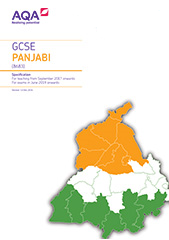3.3 Grammar
The grammar requirements for GCSE Panjabi are set out in two tiers: Foundation Tier and Higher Tier.
GCSE students will be expected to have acquired knowledge and understanding of Panjabi grammar during the course. In the exam, they will be required to apply their knowledge and understanding, appropriate to the relevant tier of entry, drawing from the following lists. The examples in brackets are indicative, not inclusive. For structures marked (R), only receptive knowledge is required.
Students will be expected to develop and use their knowledge and understanding of this grammar progressively throughout their course.
Foundation Tier
Nouns
Gender
Single and plural forms.
Direct and oblique case forms.
Adjectives
‘Black’ (inflecting) and ‘red’ (invariable) adjectives
Attributive and predicative use of adjectives
Demonstrative- proximal ਇਹ and distal ਉਹ
Indefinite ਕੋਈ
Possessive: ordinary possessive adjectives and ਆਪਣਾ interrogative (ਕਿਹ ੜਾ, ਕਿ ਸਦਾ)
Adverbs
Interrogative (ਕਿੱਥੇ, ਕਿਵੇਂ, ਕਿਉਂ)
Adverbs of time and place (ਕਿਵੇਂ, ਕਿੱਥੇ)
Relative and correlative pairs (ਕਿਵੇਂ...ਕਿਵੇਂ...) (R)
Common adverbial phrases
Particles
ਹੀ, ਵੀ
ਤਾਂ (R)
Verbs
Personal forms
Subjunctive (ਜਾਵਾਂ, ਕਰਾਂ)
Ordinary imperative (ਜਾਹ, ਕਰ)
‘Polite’ imperative (ਜਾਈਂ , ਕਰੀਂ) (R)
Adjectival forms
Imperfect participle (ਜਾਂਦਾ, ਕਰਦਾ)
Perfect participle (ਗਿਆ, ਕੀਤਾ)
Potential participal (ਜਾਣਾ, ਕਰਨਾ)
Mixed forms
Subjective + ਗਾ (‘future tense’) (ਜਾਵਾਂਗਾ, ਕਰਾਂਗਾ)
Nominal forms
Gerund (ਜਾਣਾ)
Conjunctive participle; stem + ਕੇ (ਜਾ ਕੇ)
Use of adjectival forms of verbs as adjectives eg ਵਿਦਾ ਪਾਣੀ, ਟੁੱ ਕਟਆਲਾਸ (R)
Tense forms of (ਹੈ, ਸੀ)
Auxiliary verbs ਦੇ, ਲੈ, ਸਕਦੇ, ਚੁੱਕ, ਹੋ, ਰਹਿ
Causative forms (ਕਰਨਾ – ਕਰਾਉਣਾ – ਕਰਵਾਉਣਾ)
Imperfect forms of stem + ਈ (ਕਰੀਦਾ, ਜਾਈਦਾ, ਨੱਠੀਦਾ) (R)
Simple serial verb constructions eg ਜਾਂਦਾ ਸੀ, ਜਾ ਰਿਹਾ ਸੀ, ਜਾ ਰਿਹਾ ਹੋਵੇਗਾ
Simple passive structures with perfect participle + ਜਾ (ਕੀਤਾ ਜਾਣਾ, ਪੜ੍ਹਿਆ ਜਾਂਦਾ, ਰੱਖਿਆ ਜਾਵੇਗਾ)
Agreement of the verb with the subject or the object or no agreement
Postpositions
Simple postpositions (ਤੋਂ, ਨੂੰ, ਦਾ)
Use of adverbs of place as postpositions (ਉੱਤੇ, ਹੇਠਾਂ, ਸਾਹਮਣੇ)
Compound postpositions (ਦੇ ਹੇਠਾਂ, ਦੇ ਸਾਹਮਣੇ)
Emphatic use of compound postpositions (ਦੇ ਉੱਤੇ)
Case form of ਦਾ
Case forms and various uses ਵਾਲਾ
Coordinating conjunctions
(ਅਤੇ, ਪਰ)
Subordinators
(ਕਿਉਂਕਿ, ਜਦ, ਜਦੋਂ)
Numbers (cardinal and ordinal), quantity, dates and time
Fractional numbers
ਡੇਢ, ਢਾਈ, ਸਵਾ..., ਪੌਣੇ..., ਸਾਢੇ... (R)
Higher Tier
Students entering for Higher Tier assessments will be required to apply all grammar ad structures listed for Foundation Tier, in addition to the new grammar and structures listed for Higher Tier.
Particles
ਤਾਂ
Verbs
Use of adjectival forms of verbs as adjectives eg ਵਗਦਾ ਪਾਣੀ, ਟੁੱਟਿਆ ਗਲਾਸ
‘Polite’ imperative (ਜਾਈਂ, ਕਰੀਂ)
Use of the potential participle to convey imperative meaning
Imperfect form of stem + ਈ (ਕਰੀਦਾ, ਜਾਈਦਾ, ਨੱਠੀਦਾ)
Durative/iterative forms with ਈ (ਕਰੀ ਜਾਓ, ਪੜ੍ਹੀ ਗਿਆ)
Auxiliary verbs ਆ, ਜਾ, ਰੱਖ, ਛੱਡ
Use of the imperfect participle to present ‘contrary to fact’ situations eg ਜੇ ਤੂੰ ਮਿਹਨਤ ਕਰਦਾ, ਤਾਂ ਪਾਸ ਹੋ ਜਾਂਦਾ
Longer serial verb constructions (ਜਾ ਰਿਹਾ ਹੋਵੇਗਾ, ਬਣਦਾ ਜਾ ਰਿਹਾ ਸੀ, ਲਿਖਿਆ ਪਿਆ ਸੀ, ਬਣਾਏ ਜਾਂਦੇ ਰਹੇ ਹਨ) (R)
Passive structures with perfect participle + ਹੋ (ਕੀਤਾ ਹੋਇਆ, ਧੋਤਾ ਹੋਇਆ, ਰੱਖਿਆ ਹੋਇਆ) (R)
Quasi-verb forms (ਬੈਠੇ- ਬਿਠਾਏ, ਚਲਦਿਆਂ-ਕਰਦਿਆਂ, ਕਰਦਿਆਂ ਹੋਇਆਂ) (R)
Complex sentences
More complex constructions involving the use of subordinators and relative pronounds, eg ਕਿਉਂਕਿ ਗੱਡੀ ਜਾ ਚੁੱਕੀ ਸੀ, ਇਸ ਕਰਕੇ ਮੈਨੂੰ ਟੈਕਸੀ ਫੜਨੀ ਪਈ; ਜਿਸ ਦੇ ਸਭ ਤੋਂ ਵੱਧ ਨੰਬਰ ਆਉਣਗੇ ਉਸ ਨੂੰ ਇਨਾਮ ਮਿਲੇਗਾ ।
